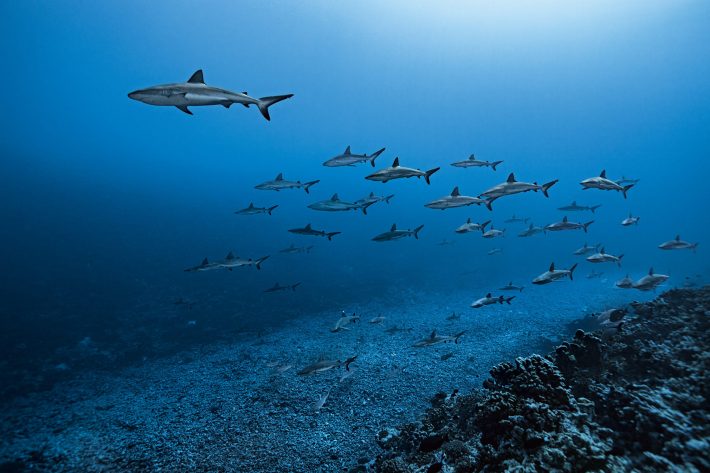When sharks need a power nap, they go surfing
FIU press release.
Surf’s up! Grey reef sharks can’t hang ten, but they’re still pretty rad surfers. New research in Journal of Animal Ecology reveals sharks surf on updrafts to conserve energy.

They’re not seeking thrills or looking to connect with nature when they take to the waves. They surf to conserve energy, according to new research led by FIU marine scientist Yannis Papastamatiou along with an international team of researchers. They found hundreds of grey reef sharks in the southern channel of Fakarava Atoll in French Polynesia are surfing the slope by floating on the updrafts from currents.
During a diving trip, Papastamatiou observed sharks swimming against the current but were barely moving their tails.
“During the day, they’re pretty placid and relaxed, swimming with minimal effort,” Papastamatiou said. “It’s interesting because it’s a pretty strong current.”
Then something really caught his attention — the sharks had developed a conveyer-belt-like system. When one shark reached the end of the line, it allowed the current to carry it back to the beginning point. The next shark in line did the same. And then the next. Papastamatiou was intrigued.
The team used a combination of acoustic tracking tags, animal-borne cameras and their own underwater observations to monitor the behaviour. They were able to calculate energy usage of those that stayed in the channel surfing and those that left the channel. By hanging out and surfing the slope, the researchers say the sharks cut their energy by at least 15 percent. For an animal that can never stop swimming (since that’s how they get oxygen), the surfing action gives them some much-needed rest.
Fakarava is a famous dive site and home to 500 grey reef sharks. Papastamatiou joined marine biologist and underwater photographer Laurent Ballesta and others on a trip to film the French research documentary 700 Requins Dans La Nuit, which National Geographic later aired as the shortened version 700 Sharks. They were there to document the sharks’ after-dark behaviour when the channel becomes a hunting ground. But it was during the daytime dives when Papastamatiou realized many of the sharks remained in the channel even though they weren’t actively hunting.
He worked with longtime collaborator Gil Iosilevskii from the Technion – Israel Institute of Technology to use a detailed map constructed from the multibeam sonar system to predict and model where possible updrafts might appear, depending on the direction of the tides. The team then put tracking receivers along the channel to capture the sharks’ location. More than 40 gray reefs also had special tags to gather data on their activity and swimming depth.
Marine environments are a lot more dynamic because of the water currents, which are much less predictable.
Data confirmed the sharks stayed in the channel during the day and selected updraft areas. To save maximum energy, the sharks also changed how deep down they go to surf the slope. During incoming tides with strong updrafts, they went deeper where the current was weaker. During outgoing tides, when there’s more turbulence, they moved closer to the surface for a smoother ride.
“This study is a nice demonstration of energy seascapes, a spatial representation of how much energy it costs an animal to move through an environment,” Papastamatiou said. “Marine environments are a lot more dynamic because of the water currents, which are much less predictable. They can change seasonally, throughout the day and even minute by minute. Ultimately, the energy seascape helps explains why these animals are in this channel hanging out there during the day. Now we have an answer.”
These findings could also apply to other coastal areas, and possibly explain why there may be larger numbers of sharks in certain places. It could even help predict why sharks may prefer one area over another.
You can read the full article for free (for a limited time) here:
, , , , , , , & (2021). Sharks surf the slope: Current updrafts reduce energy expenditure for aggregating marine predators. Journal of Animal Ecology, 00, 1– 13. https://doi.org/10.1111/1365-2656.13536
Media contact:
Angela Nicoletti
T: 305-348-4493. E:anicolet@fiu.edu
news.fiu.edu @FIUNews
Like what we stand for?
Support our mission and help develop the next generation of ecologists by donating to the British Ecological Society.